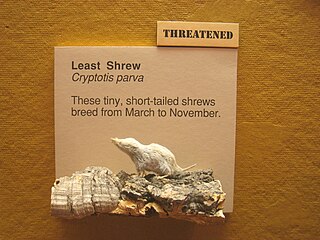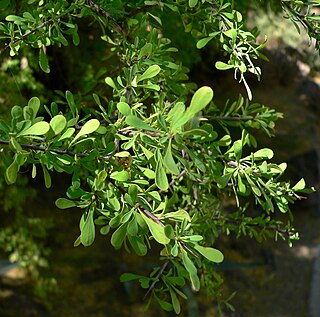
Centropomus is a genus of predominantly marine fish comprising the family Centropomidae The type species is Centropomus undecimalis, the common snook. Commonly known as snooks or róbalos, the Centropomus species are native to tropical and subtropical waters of the western Atlantic and eastern Pacific Oceans.

The black-throated gray warbler or black-throated grey warbler is a passerine bird of the New World warbler family Parulidae. It is 13 cm (5.1 in) long and has gray and white plumage with black markings. The male has the bold black throat of its name, and black stripes on its head, as well as black streaks on its flanks; the female is a paler version of the male, with a white throat and less distinct black markings on the flanks and wings. It breeds in western North America from British Columbia to New Mexico, and winters in Mexico and the southwestern United States. The habitats it prefers are coniferous and mixed forests and scrubland, especially those with pinyon pines, junipers, sagebrush, and oaks. Its nest is an open cup of plant fibers lined with feathers, built a few metres from the ground in the branches of a tree or shrub. Three to five eggs are laid, and young are fed by both parents. Common in its breeding range, it does not seem to be seriously threatened by human activities, unlike many migratory warblers.

The red-toothed shrews of the subfamily Soricinae are one of three living subfamilies of shrews, along with Crocidurinae and Myosoricinae. In addition, the family contains the extinct subfamilies Limnoecinae, Crocidosoricinae, Allosoricinae and Heterosoricinae. These species are typically found in North America, northern South America, Europe and northern Asia. The enamel of the tips of their teeth is reddish due to iron pigment. The iron deposits serve to harden the enamel and are concentrated in those parts of the teeth most subject to wear.

The genus Cryptotis is a group of relatively small shrews with short ears, which are usually not visible, and short tails, commonly called small-eared shrews. They have 30 teeth and are members of the red-toothed shrew subfamily. Since 1992, Neal Woodman at the United States National Museum has been in the process of revising the genus. To date, this has resulted in an increase in the number of species from 12 to 30.

The scaled quail, also commonly called blue quail or cottontop, is a species of the New World quail family. It is a bluish gray bird found in the arid regions of the Southwestern United States to Central Mexico. This species is an early offshoot of the genus Callipepla, diverging in the Pliocene.

The white-eared hummingbird is a small hummingbird. It is 9–10 cm long, and weighs approximately 3-4 g.

Condalia is a genus of spiny shrubs in the tribe Rhamneae of the buckthorn family, Rhamnaceae. It was named for Antonio Condal, an 18th Spanish physician. Members of the genus are native to tropical and subtropical deserts and xeric shrublands in North and South America. The ranges of each species vary considerably; some are confined to only a few square miles, while others can be found on an area up to 1,000 sq mi (2,600 km2).

The blackish small-eared shrew is a species of shrew in the family Soricidae. It is found in parts of Costa Rica, El Salvador, Guatemala, Honduras, Mexico, and Panama. An example specific habitat is the Petenes mangroves of the Yucatán.

The Himalayan shrew is found in Bhutan, China, India, Myanmar, and Nepal, is currently the only species in the genus Soriculus within the tribe Nectogalini, although the species Chodsigoa and Episoriculus, which occur in southeastern Asia, as well as those of the fossil European genus Asoriculus, were formerly included there.
The Guzmán Basin is an endorheic basin of northern Mexico and the southwestern United States. It occupies the northwestern portion of Chihuahua in Mexico, and extends into southwestern New Mexico in the United States.

The Tamaulipan mezquital is a deserts and xeric shrublands ecoregion in the southern United States and northeastern Mexico. It covers an area of 141,500 km2 (54,600 sq mi), encompassing a portion of the Gulf Coastal Plain in southern Texas, northern Tamaulipas, northeastern Coahuila, and part of Nuevo León.

Crassispira nigrescens is a species of small predatory sea snail, a marine gastropod mollusk in the family Pseudomelatomidae,.

Polites sabuleti, the sandhill skipper or saltgrass skipper, is a butterfly in the family Hesperiidae. It is found from southern British Columbia and eastern Washington, south through California and northern Arizona to Baja California and east to south-eastern Wyoming, central Colorado, and north-eastern New Mexico. It is an introduced species in Hawaii.
Eupithecia flavigutta is a moth in the family Geometridae first described by George Duryea Hulst in 1896. It is found in the United States in Colorado and montane forest areas in eastern Arizona and south-western New Mexico.

Eupithecia anticaria is a moth in the family Geometridae first described by Francis Walker in 1862. It is found from eastern Newfoundland and Labrador across Canada to western British Columbia, south to northern New Mexico and Apache and Coconino counties in Arizona.
Eupithecia macfarlandi is a moth in the family Geometridae first described by Clifford D. Ferris in 2007. It is found in canyons on the east side of the Huachuca Mountains in the US state of Arizona. The habitat consists of oak and oak-conifer forests.
Phoradendron coryae, Cory's mistletoe or oak mistletoe, is a hemiparasitic plant native to the southwestern United States and northern Mexico. It is reported from Arizona, New Mexico, Texas, Chihuahua, Coahuila and Sonora.

Philonome nigrescens is a species of moth of the family Tineidae. It is found in the south-western United States, where it has been recorded from Arizona and New Mexico.
Caberini is a tribe of geometrid moths in the family Geometridae. There are at least 50 described species in Caberini.
Pterospoda opuscularia is a species of geometrid moth in the family Geometridae. It is found in North America.
















